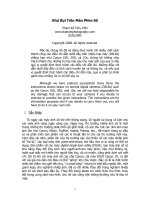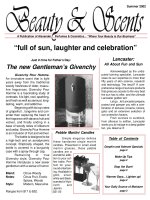Portraiture lesson pdf
Bạn đang xem bản rút gọn của tài liệu. Xem và tải ngay bản đầy đủ của tài liệu tại đây (72.03 KB, 7 trang )
Portraiture lesson
Time : Allow 40min
Aim : To study draw a portratit using the 'inside-out' method.
Materials : The sketch pad, HB and 4B pencil, eraser, a ruler for
measurements if need be.
Allow five minutes to for the quick sketch test. Two minutes to do and
three to mark. Swap, display and title if necessary.
Mostly everything we draw is based on regular solids such as cubes, spheres,
cylinders and pryramids or a combination of them all. In this lesson we
shall be using a sphere, a half-pyramid and a cylinder.
Sphere Pyramid Split pyramid
First we construct a light circle in the approximate position and size shown
below.
Draw another circle in the position shown (exactly one full circle apart).
Using a nice 'sickle moon' arc describe the edges of the shadows that will
give the spheres some depth.
Shade in the shadow parts of the twin spheres.
Copy the eye shapes from my drawing being careful to keep them level and
sketch the little inside corners as I have done.
Add the eyelids and circle in the iris and pupils as shown below. To make
the eyes look right or left you would position the pupils accordingly.
Shade in the pupils and irises. Remember the pupils are actually holes and
therefore shadows.
Using your eraser make the small highlights in the eyes that give them their
sparkle. The amount of 'sparkle' should differ from one eye to the other.
Sometimes you would 'sparkle' one eye only as the other might be in shade.
Careful observation is the key.
You can suggest some eyelashes at this stage. Next we will construct the
pyramid that will give us our 'design' for our nose. All you will need to do in
the future is to remember these basic structures when doing your portraits.
The 'length' of the nose will obviously differ between individuals but not
too much. The distance between the eyes will often vary slightly as well but
once you know the approximate distances as I have given you you can make
the minor adjustments yourself.
With a little shading and careful edges on the base of the nose you will be
able to suggest the shape. Try not to include too many details at this stage.
Next we will look at the lips
Lips are best visualized as part of a cylinder as they 'wrap around' the face.
Here I have dawn the 'classic' shape with mouth closed. Using similar
proportions construct your own as shown below.
Now add a little bit of shading and complete your drawing as shown.
HOMEWORK
Complete both eyes and more shading.









